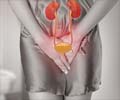- Neurogenic Bladder - (http://dx.doi.org/10.1155/2012/816274)
- Bladder Control Problems & Nerve Disease - (http://www.niddk.nih.gov/health-information/health-topics/urologic-disease/nerve-disease-and-bladder-control/documents/nervedisease_508.pdf)
- About Bladder Control Problems & Nerve Disease - (http://www.niddk.nih.gov/health-information/health-topics/urologic-disease/nerve-disease-and-bladder-control/pages/facts.aspx)
- Inoue S, Saito M, Honda M, Dimitriadis F, Takenaka A (2012) Intravesical Oxybutynin for Neurogenic Bladder in Children. Pediat Therapeut 2:138.doi: 10.4172/2161-0665.1000138
What is Neurogenic Bladder?
Neurogenic bladder is a nerve-related disorder which affects the function of the urinary bladder and urethral sphincters. It causes severe inconvenience to the patient and affects the quality of life.
Neurogenic bladder is the name given to a number of urinary conditions in people who lack bladder control due to a brain, spinal cord or nerve problem.
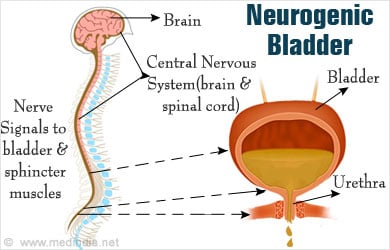
The urinary system consists of the kidneys which produce urine, the ureters which are tube-like structures that carry the urine to the bladder, the muscular urinary bladder that stores the urine and the urethra through which the urine passes out of the body. The urethra is kept closed by two sphincters, the internal and external urethral sphincters.
The brain, spinal cord and peripheral nerves control the process of passing urine, also called micturition. As the urinary bladder fills with urine, it is relaxed and the sphincters are closed. When the bladder is full, signals are sent to the brain. The brain informs the lower urinary system not to empty unless it is socially unacceptable to do so. Once it is favorable to pass urine, the nerves supplying the urinary tract co-ordinate in such a way that bladder contraction is accompanied by the relaxation of the urethral sphincters, so that emptying can take place. The internal urethral sphincter is under involuntary control, while the external urethral sphincter is under voluntary control.
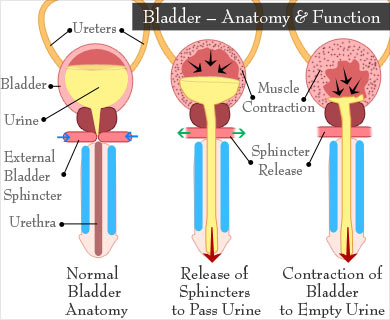
A neurogenic bladder may result in:
- An overactive or spastic bladder, associated with frequent urges for urination
- A paralyzed bladder, where the bladder cannot contract to evacuate the urine.
- A very tight urethral sphincter, which does not allow the bladder to empty, resulting in urinary retention. If the urinary sphincter is also spastic, the pressure in the bladder rises, and the urine may reflux into the ureters, and even into the kidneys
- A very loose urethral sphincter, resulting in urinary incontinence or leakage
- Lack of coordination between the bladder and the urinary sphincters
What are the Causes of Neurogenic Bladder?
Neurogenic bladder is caused by various conditions that result in loss of nerve control over the bladder. These include conditions that affect the:
- Brain -
- Stroke,
- Brain tumor
- or Parkinson’s disease
- Spinal cord -
- Tumor
- Injury
- Multiple sclerosis
- Peripheral nerves -
- Surgery or trauma to the pelvic regions and nerve damage
- Guillain-Barre syndrome
- Diabetes
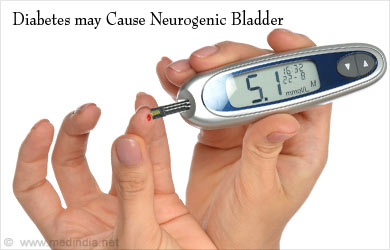
What are the Symptoms of Neurogenic Bladder?
Neurogenic bladder may result in one or more symptoms -
- Urinary retention
- Frequency of urination
- Painful voiding
- Difficulty in passing or initiating urinations
- Incomplete voiding
- Urgent desire to pass urine
- Urgent desire to pass urine that cannot be controlled and results in incontinence
- Constant dribbling of urine or Incontinence
When there is an acute injury to the spinal cord or if the nerves or damaged during pelvic surgery, the situation is more acute and in this situation the patients will mostly have retention of urine. The catheter removal after a few days may not be successful in such situations.
Urinary retention may result in:
- Urinary Infections - Repeated urinary tract infections which can even spread to the kidneys. Typical symptoms of infection like high fever may be present. The infection may spread to the blood making the patient highly toxic, and may even result in death.
- Kidney Damage- Damage to the kidneys when the urine is forced back into them, even resulting in kidney failure.
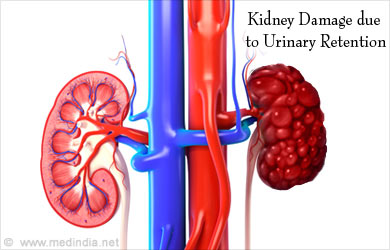
Urinary incontinence may result in:
- Social implications for the patient like social isolation due to the leakage and sometimes the odor. This may also lead to depression.
- Skin erosions ulcers may result around the private parts, which give rise to pain and make walking difficult.
How is Neurogenic Bladder Diagnosed?
Neurogenic bladder is diagnosed based on:
- The history of the patient, where the patient gives details of the pattern of passing urine, and of any other underlying condition that may be causing the problem
- Physical examination, which should include local examination as well as examination of the nervous system to identify the underlying cause
- Laboratory tests, which include blood tests for kidney function, or urine tests to detect infection
- X-rays, MRI, CT Scan - Imaging studies of the urinary tract including bladder like contrast study of the bladder or cystogram, CT scan and MRI if injury or disease of the brain and/or spinal cord is suspected.
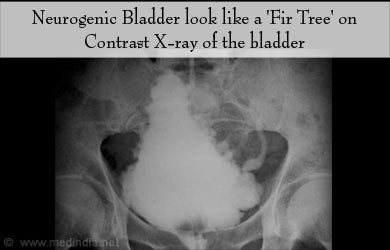
- Isotope studies such as renogram - to study the kidney function
- Post void residual urine - Ultrasound may be used to measure the amount of urine retained in the bladder after passing urine, which is referred to as post void residual urine. A post void residual urine of more than 100 to 150 ml makes it prone to infection.
- Urodynamic tests to study the function of the bladder and the sphincters. These tests study aspects like urine flow rate, bladder and urethral sphincter pressures and determine the exact functional problem with urination.
The study is divided into two parts – a filling study to look at the bladder resting pressures and a voiding study to look at bladder pressures and also to look at functioning of urinary sphincters. The study needs to be done when the urine is sterile and takes about an hour to perform. A special appointment needs to be booked at a urology clinic or a hospital department for this test to be conducted.
Video-urodynamics - The above study when done with x-ray control is also called video-urodynamics. The x-ray provides additional information about the relaxation of sphincters when voiding and also if there is any associated reflux of urine into the kidneys.
- Cystoscopy may be done to rule out any other bladder conditions. Cystoscopy is a procedure, which involves inspection of the inner surface of the urinary bladder through a telescope-like instrument inserted through the urethra.
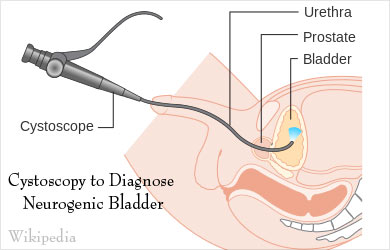
How do you Treat Neurogenic Bladder?
Bladder dysfunction may recover once the underlying cause is treated. However, since several causes of neurogenic bladder cannot be treated, treatment of neurogenic bladder involves maintaining adequate drainage of urine and avoiding incontinence episodes.
Long term management strategies for neurogenic bladder need to focus on two important aspects -
- Quality of life issues to overcome with urinary retention & /or urinary incontinence and urinary infections
- Prevention of kidney damage due to possible high bladder pressures
Approaches to the treatment include the following:
Treatment of urinary retention & Incontinence:
- External pressure on bladder - If urinary retention occurs due to lack of bladder contractions, the patient may be advised to put pressure on the lower abdomen manually or through coughing so that urine can be passed. The patient in such situations empties the bladder by manual contraction.
- Clean Intermittent Catheterization or CIC - The patient may be taught to self-catheterize the bladder at regular intervals; this is referred to as clean self intermittent catheterization. During catheterization, a tube called a small catheter is passed through the urethra and the urine is drained out fully. This procedure needs to be done 4 to 5 times a day to make sure that no urine leaks in between. It needs to be done in a sterile manner otherwise it can lead to infections. The patient is trained by a urologist or a nurse into how to ensure this sterility. The patient is also advised on the total amount of fluid that should be taken per day.
This method of treatment has become the mainstay in managing many patients with neurogenic bladder, who otherwise would have been doomed to live with permanent catheters. Long term indwelling catheters are associated with number of physical and social problems such as repeated infections, irritations and erosion of the urethra to name a few.
- Patients who cannot do intermittent catheterization may need to be put on continuous catheterization. If this is the only way of urinary drainage for long term then it is advised that they have a catheter inserted through a small incision through their lower abdomen directly into the bladder rather than having a tube through the urethra. In this procedure, a Foley’s catheter or suprapubic catheter is inserted into the bladder for drainage. A patient on catheterization should take adequate fluids and citrate to prevent infections and stone formation.
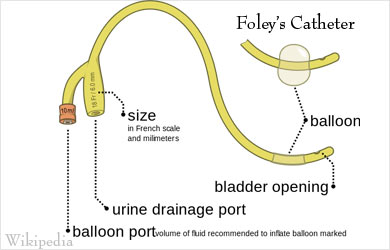
Role of Medications in Managing Neurogenic Bladder -
Drugs are used along with other measures to control the symptoms of neurogenic bladder. Depending on the type of neurogenic bladder and symptoms, various types of medications can be prescribed -
1. Drugs that relax the urethral sphincter - facilitate emptying of the bladder. These include:
- Drugs like terazosin, tamsulosin, alfuzosin, and doxazosin, which act on the bladder neck to relax the urinary sphincter
- Benzodiazepines and baclofen, which act at the level of the brain and spinal cord.
- Botulinum toxin, which may be used to relax an overactive bladder and spastic urethral sphincter in patients with spinal cord injuries.
2. Drugs used to improve bladder contraction - Bethanechol may be used to bring about bladder contractions when the tone of the bladder is decreased.

Surgical Options to Release Tight External Sphincter -
- For patients with a tight urinary sphincter, a surgical procedure to loosen the sphincter using electrical energy or laser called sphincterotomy may be carried out.
- Injection of Botulinum into the external urethral sphincter may provide temporary relief for 6 to 9 months.
- Insertion of urethral stents can keep the urethra patent following the procedure.
Treatment of Urinary Incontinence:
- Intermittent catheterization may be done to prevent incontinence due to overflow bladder. In this condition the bladder is always full and whenever it fills beyond a point some urine dribbles out – this is called overflow incontinence. By putting in a catheter the bladder is emptied at regular intervals so that accidents due to urinary leakage can be avoided.
- For men with incontinence who cannot catheterize, a condom catheter can be used. A condom catheter has a condom placed over the penis, and drains through a tube into a urine bag.
- Incontinence pads or adult diapers may also be used, but they can result in skin erosions and urinary tract infections.
- Drugs to quieten the spontaneous bladder contractions – if there are symptoms of urgency and urge incontinence and the urodynamics indicate such contractions along with high bladder pressures than drugs called anti-cholinergics or tricyclic antidepressants are prescribed and these include -
- Oxybutanin
- Tolterodine
- Solifenacin
- Darefancin
- Trospium
- Fesoterodine
These drugs can have some side effects such as dry mouth, constipation and sometimes memory problems.
These are usually given orally, but oxybutynin can be instilled into the bladder.
- Tricyclic antidepressants - which are used in the treatment of depression, reduce the tone of the urinary bladder, due to their additional anticholinergic action. One of the tricyclic antidepressants, imipramine, also increases the tone of the bladder sphincter and has an anesthetic effect on the inner lining of the bladder, thereby reducing contractions.
- Surgical procedures in urinary incontinence are directed to increasing the bladder capacity and thereby reducing the pressure in the bladder.

- In patients with small spastic bladders, a surgical procedure called cysto-enteroplasty may be carried out. In this procedure, a part of the intestine is attached to the bladder to increase its capacity. Another similar procedure is bladder autoaugmentation, where a partial cut is made in the muscle of the bladder to create a pouch and increase its capacity. The patient may require intermittent catheterization following the procedures.
- Sacral nerve root stimulation may be used for the treatment of overactive bladder. An electrical stimulator is surgically implanted which stimulates the nerves supplying the bladder. However, the effect may last only for one to four years.
- Artificial urethral sphincters and sling procedures may be used to control incontinence. Artificial urethral sphincters keep the urethra closed and allow the patient to release the urine at a convenient time and place. Sling procedures create a sling of natural or artificial materials that support the urethra and help to treat urinary incontinence that occurs following coughing etc.



